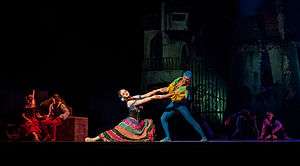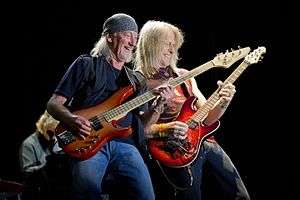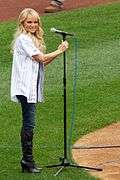Performance

Performance is completion of a task with application of knowledge, skills and abilities.[1] In work place, performance or job performance means good ranking with the hypothesized conception of requirements of a task role, whereas citizenship performance means a set of individual activity/contribution (prosocial organizational behavior) that supports the organizational culture.[2][3] In the performing arts, a performance generally comprises an event in which a performer or group of performers present one or more works of art to an audience. In instrumental music (and in drama), performance is typically described as "play".[4] Usually the performers participate in rehearsals beforehand. An effective performance is determined by achievement skills and competency of the performer - level of skill and knowledge. Spencer and McClelland in 1994 defined competency as "a combination of motives, traits, self-concepts, attitudes, cognitive behavior skills (content knowledge)" that helps a performer to differentiate themselves superior from average performers.[5] A performance may also describe the way in which an actor performs. In a solo capacity, it may also refer to a mime artist, comedian, conjurer, or other entertainer.
Performance state

Williams and Krane found the following characteristics define an ideal performance state:[6]
- Absence of fear
- Not thinking about the performance
- Adaptive focus on the activity
- A sense of effortlessness and belief in confidence or self-efficacy
- A sense of personal control
- A distortion of time and space where time does not affect the activity
Other related factors are motivation to achieve success or avoid failure, task relevant attention, positive self-talk and cognitive regulation to achieve automaticity. Performance is also dependent on adaptation of eight areas: Handling crisis, managing stress, creative problem solving, knowing necessary functional tools and skills, agile management of complex processes, interpersonal adaptability, cultural adaptability, and physical fitness.[7] Performance is not always a result of practice, it is about honing the skill, even over practice itself can result in failure due to ego depletion.[8]
Stage fright

Theatrical performances, especially when the audience is limited to only a few observers, can lead to significant increases in the performer's heart rate above his or her baseline heart rate. This increase takes place in several stages relative to the performance itself, including anticipatory activation (one minute before the start of subject's speaking role), confrontation activation (during the subject's speaking role, at which point their heart rate peaks) and release period (one minute after the conclusion of the subject's speech).[9] The same physiological reactions can be experienced in other mediums, such as instrumental performance. When experiments were conducted to determine whether there was a correlation between audience size and heart rate (an indicator of anxiety) of instrumental performers, the researcher's findings ran contrary to previous studies, showing a positive correlation rather than a negative one.[10]
Heart rate shares a strong, positive correlation with the self reported anxiety of performers.[11] Other physiological responses to public performance include perspiration, secretion of the adrenal glands, and increased blood pressure.[12]
See also
References
- ↑ John Shields; Michelle Brown; et al. (2015). Managing Employee Performance and Reward: Concepts, Practices, Strategies. Cambridge University Press. pp. 125+. ISBN 978-1-316-4-4115-2.
- ↑ Winston Bennett; Charles E. Lance; David J. Woehr (2014). Performance Measurement: Current Perspectives and Future Challenges. Psychology Press. pp. 115–116. ISBN 978-1-317-82454-1.
- ↑ Sonnentag, S & Frese, M. (2009). Dynamic Performance. In S.W.J Kozlowski (Ed.), The Oxford Handbook of Industrial and Organizational Psychology
- ↑ Andreas Dorschel, Music as Play. In: Paulo de Assis (ed.), Virtual Works – Actual Things: Essays in Musical Ontology. Leuven University Press, Leuven 2018 (Orpheus Institute Series), pp. 115–133. pdf online
- ↑ Shippmann, Jeffery S.; Ash, Ronald A.; Batjtsta, Mariangela; Carr, Linda; Eyde, Lorraine D.; Hesketh, Beryl; Kehoe, Jerry; Pearlman, Kenneth; Prien, Erich P.; Sanchez, Juan I. (2000). "THE PRACTICE OF COMPETENCY MODELING". Personnel Psychology. 53 (3): 703–740. doi:10.1111/j.1744-6570.2000.tb00220.x. ISSN 0031-5826.
- ↑ Haff , G. Gregory; Triplett , N. Travis (2015). Essentials of Strength Training and Conditioning (4th ed.). Human Kinetics. pp. 156–57. ISBN 978-1-4925-0162-6.
- ↑ Frank J. Landy; Jeffrey M. Conte (2010). Work in the 21st Century: An Introduction to Industrial and Organizational Psychology. John Wiley & Sons. p. 193. ISBN 978-1-4051-9025-1.
- ↑ Smith, J. L., Hardy, T., & Arkin, R. (2009). When practice doesn't make perfect: Effort expenditure as an active behavioral self-handicapping strategy. Journal of Research in Personality, 43(1), 95-98. https://dx.doi.org/10.1016/j.jrp.2008.10.004
- ↑ Baldwin, Sandra (1980). "Effect of Speakers' Sex and Size of Audience on Heart-Rate Changes During Short Impromptu Speeches". Psychological Reports. 46: 123–130. doi:10.2466/pr0.1980.46.1.123. PMID 7367532.
- ↑ Studer, Regina (2014). "Psychophysiological Activation During Preparation, Performance, and Recovery in High- and Low-Anxious Music Students". Applied Psychophysiology and Biofeedback. 39 (1): 45–57. doi:10.1007/s10484-014-9240-2.
- ↑ Maclntyre, Valerie (2010). "Heart Rate Variability as a Predictor of Speaking Anxiety". Communication Research Reports. 27 (4): 286–297. doi:10.1080/08824096.2010.496323.
- ↑ Brutten, Eugene (1963). "A Palmer Sweat Investigation of the Effect of Audience Variation Upon Stage Fright". Speech Monographs. 30: 92–96. doi:10.1080/03637756309375363.